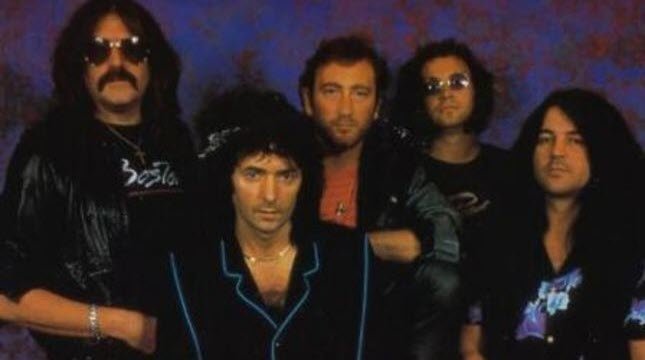
Smoke, Soul, and Shredding: The 10 Deep Purple Tracks That Defined Rock History…Read More…
In the electrifying pantheon of rock history, Deep Purple remains a towering force—an uncompromising blend of gritty riffs, thundering drums, and electrifying stagecraft. Rising from the British hard rock scene of the late 1960s, the band quickly established itself as more than just another long-haired collective playing loud music. Deep Purple fused classical elements with heavy blues rock, creating a genre-defining sound that inspired generations of musicians and birthed anthems etched into the DNA of rock ‘n’ roll.
Today, we take a deep dive into ten Deep Purple tracks that didn’t just top charts or fuel concert pyrotechnics—they redefined what rock music could be. From soul-shaking vocals to jaw-dropping guitar solos, these songs embody the smoke, soul, and shredding that made Deep Purple immortal.
1. Smoke on the Water (1972)
No list of Deep Purple songs would dare omit this classic. With its instantly recognizable four-note riff, “Smoke on the Water” is the anthem that made millions pick up a guitar. Inspired by a real-life fire at the Montreux Casino in Switzerland during a Frank Zappa concert, the song transformed tragedy into triumph. Ian Gillan’s vivid storytelling, coupled with Ritchie Blackmore’s minimalistic yet iconic riff, crafted a timeless narrative that resonates across decades. It’s more than a song—it’s a rite of passage for rock fans.
2. Highway Star (1972)
The ultimate driving anthem, “Highway Star” is pure adrenaline. Opening Deep Purple’s seminal live album Made in Japan, this track is a blistering showcase of each member’s prowess. Jon Lord’s organ solo borders on classical fugue, Blackmore’s guitar solo melts faces, and Gillan’s vocals are sheer fire. The band claims it was written on a tour bus in minutes—proof that magic doesn’t always take time.
3. Child in Time (1970)
Clocking in at over ten minutes, “Child in Time” is Deep Purple’s progressive masterpiece. A haunting ballad that swells into a sonic volcano, the song showcases Gillan’s operatic range and Lord’s eerie organ passages. Lyrically dark and emotionally raw, it’s a lament against war and human suffering, and a testament to the band’s willingness to push beyond the hard rock formula. The live versions? Even more transcendent.
4. Perfect Strangers (1984)
The 1980s saw Deep Purple reunite their classic MK II lineup, and with it came “Perfect Strangers”—a slow-burning, epic track with mystique and menace. Its hypnotic keyboard riff, eerie lyrics, and heavy aura signaled that the band hadn’t lost an ounce of creative thunder. It’s proof that the reunion wasn’t nostalgia—it was resurgence.
5. Burn (1974)
Enter David Coverdale and Glenn Hughes. “Burn” was the explosive title track of the band’s first post-Gillan era album, and what a statement it was. A flurry of galloping riffs, dual-vocal harmonies, and breakneck tempo changes, the song demonstrated that Deep Purple could evolve without losing their identity. It remains a fan-favorite and a live show mainstay.
6. Lazy (1972)
Don’t let the name fool you—“Lazy” is a tour de force of jam-band improvisation. Jon Lord’s playful organ intro sets the tone, leading into one of the funkiest and grooviest rock songs in the band’s repertoire. The track feels like a musical conversation, with Lord, Blackmore, and Paice trading licks and fills in a fluid dance of musicianship.
7. Hush (1968)
Before Gillan, before Blackmore’s guitar pyrotechnics became legend, there was “Hush.” Deep Purple’s breakthrough hit—originally written by Joe South and recorded by Billy Joe Royal—was given new life by the band’s early lineup. Rod Evans’ vocals, Jon Lord’s pounding organ, and the vibrant energy catapulted the band into the American charts. It marked the birth of a phenomenon.
8. Space Truckin’ (1972)
In “Space Truckin’,” Deep Purple sent rock into orbit. The track merges sci-fi imagery with heavy riffing, creating an interstellar journey built on grooves and grit. Its extended live versions became showcases for improvisation and showmanship—some lasting over 20 minutes with spaceship-like effects and frenzied solos. It’s cosmic, chaotic, and quintessentially Purple.
9. When a Blind Man Cries (1972)
Though it was originally a B-side, “When a Blind Man Cries” has grown into one of Deep Purple’s most beloved ballads. A departure from their usual bombast, the track is stripped-down and bluesy, anchored by emotional lyrics and a searing Blackmore guitar solo. It’s the band at their most vulnerable—and most human.
10. Fireball (1971)
Opening with an almost mechanical hum—often believed to be a bass drum pedal against a studio floor—“Fireball” races ahead with punkish energy. It showcased a band willing to experiment, incorporating speed and rhythm in a way that anticipated heavy metal’s future. The track remains a testament to their innovative spirit during the early ’70s.
Why Deep Purple Still Matters
What sets Deep Purple apart is their uncanny ability to balance raw power with refined musicality. They weren’t just about volume—they were about virtuosity. Each lineup change didn’t mark a decline, but a rebirth. Whether it was the classically-tinged solos of Jon Lord, the mystical bravado of Ritchie Blackmore, or the soul-infused vocals of David Coverdale and Glenn Hughes, the band continually reinvented itself without losing its core identity.
In 2016, Deep Purple was finally inducted into the Rock and Roll Hall of Fame—a recognition many fans felt was long overdue. But accolades aside, their true legacy lies in these songs: in every garage band cover of “Smoke on the Water,” every air guitar riff to “Burn,” every teary listen to “When a Blind Man Cries.”
These ten tracks aren’t just songs. They’re chapters in the sacred book of rock. And Deep Purple? They’re the authors of its loudest, most electrifying pages.
Which Deep Purple classic changed your life? Let us know in the comments.
Leave a Reply